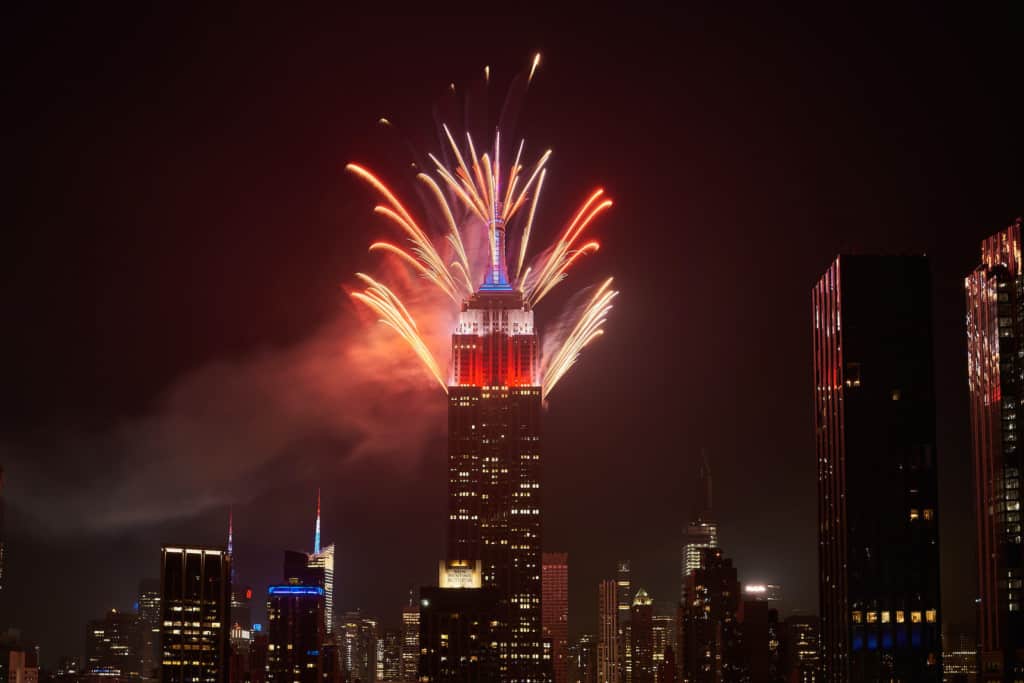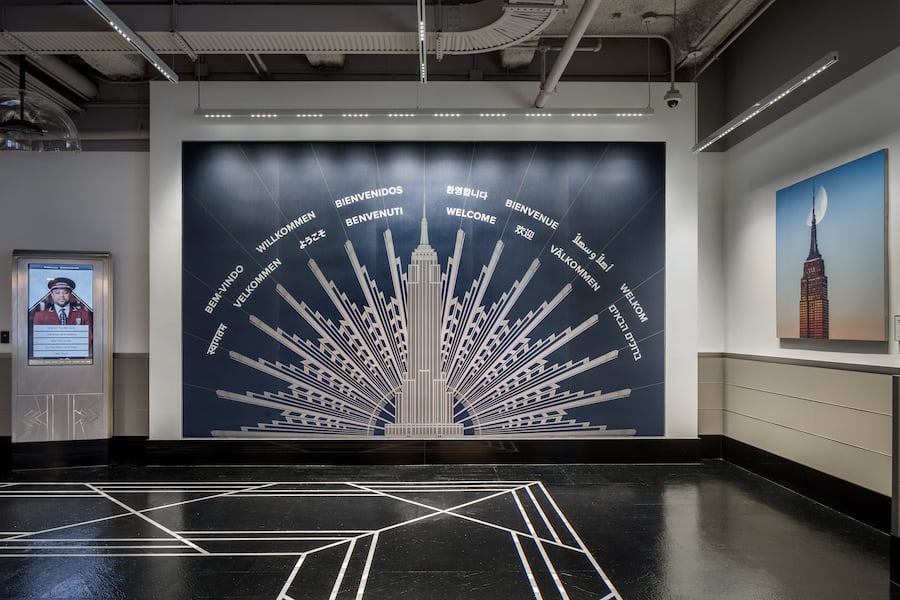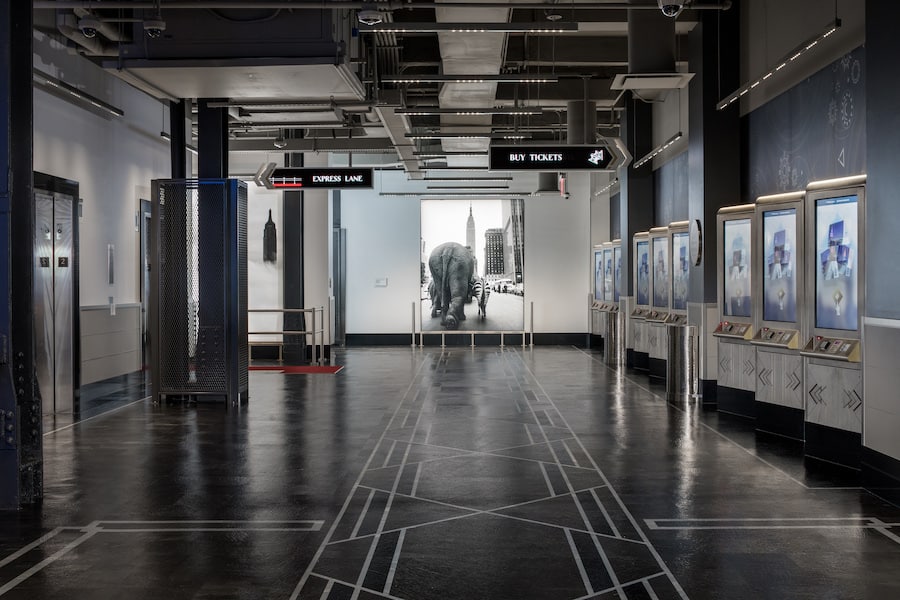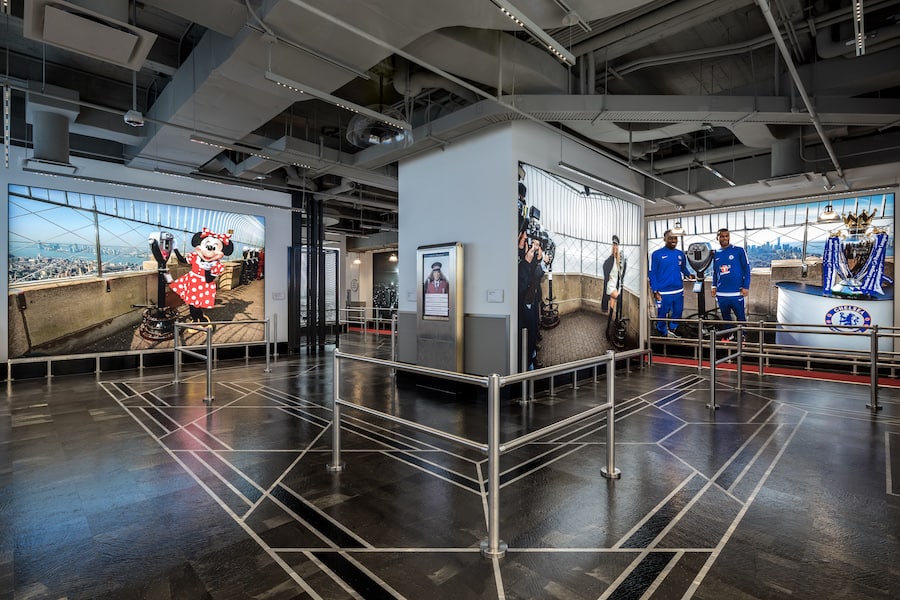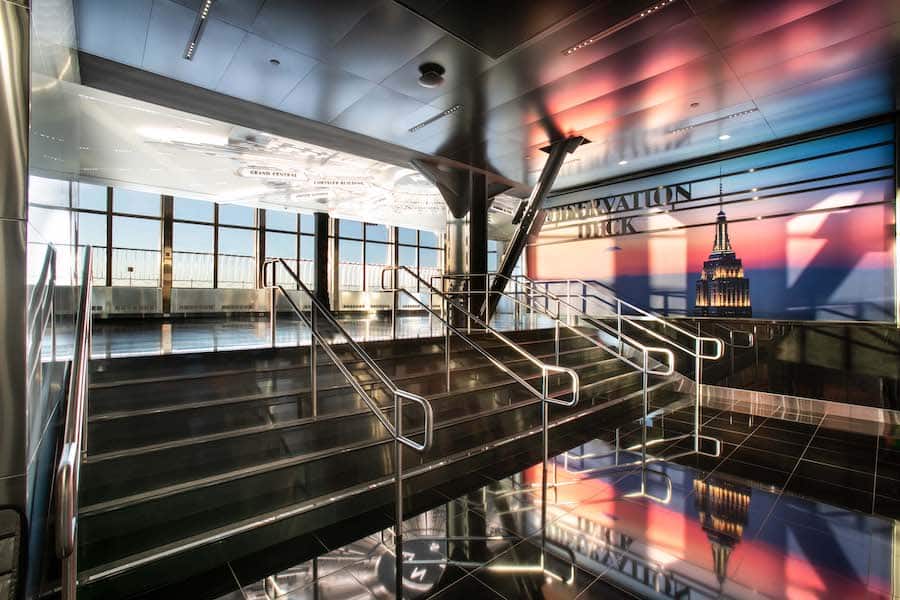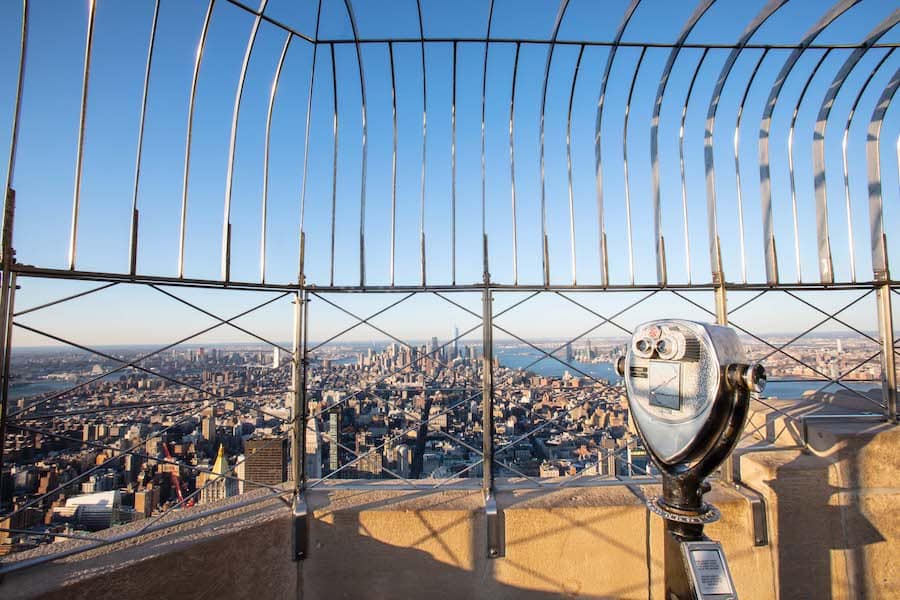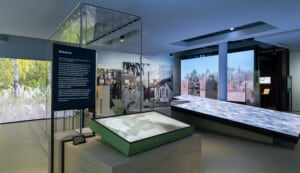Jean-Yves Ghazi, President of the Empire State Building Observatory, and Holly Houghton, Managing Director of the New York studio for Squint/Opera spoke to blooloop about the project. Squint/Opera worked beside Thinc Design and Antfood to create the new permanent immersive digital exhibition, which is part of the reimagined top-to-bottom Observatory Experience.
Ghazi says he was born to be in the hospitality business:
“I’ll give you a little insight. I grew up in West Africa and I remember one time my dad and I were on the beach on the coast of Freetown, Sierra Leone. We saw a father and son, in the rough surf, and the son was drowning. My father and I were excellent swimmers. We quickly jumped into the water. It was my first save.”
This was the start of a career in water safety. Ghazi went into the water and amusement park industry for about a decade.
“It was a lot of fun, and also focused on safety and making a difference in the guest experience,” he says. “I then joined the harbour cruise excursion business, which is also all about entertaining and delivering memorable experiences to guests. I have dedicated my entire career to the attraction industry, and it’s been an incredibly rewarding and simply delightful journey.
“Hospitality has always been in my blood, and that is what brought me to the Empire State Building in 2008, to lead the most iconic attraction in New York City.”
The iconic Empire State Building
The Empire State Building is perhaps the most iconic building in the world, and one to which everyone feels an emotional connection.
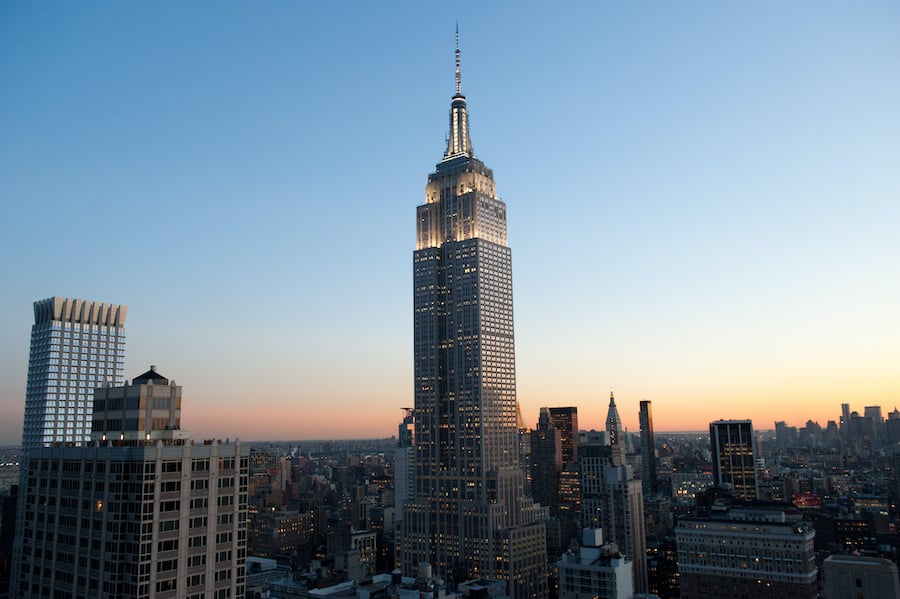
Ghazi describes how that universal reaction can be leveraged:
“We polled our visitors. Everyone aspires to come to the Empire State Building, before even arriving into New York City. All our polled customers put the building on the top of their “must-do” bucket list.
“When this whole project started, our initial step was to find out from our visitors what they thought of their Empire State Building experience. Everybody acknowledged the fact that they had an emotional connection with the building, and wanted more. They were looking for unique ways to connect with it. They wanted to be insiders, but not quite experts.”
Consulting a wide audience
The project’s inception came about in late 2014.
“The initial plan to begin to craft this experience and launch into this project started in late fall of 2014,” says Ghazi. “It began with assembling the best in class teams, led by Thinc Design, who was selected to lead the project on our behalf.
“Everything that we’ve created was informed by the results of our on-going polling of our visitors. We tested all concepts and the final experience elements were informed by the results of our polling.”
“Throughout the journey and the process, everything was influenced and informed by visitor reactions to concepts, to beta displays, and to interactive exhibits that we rolled out into the observatory spaces to test visitor reaction.
“That validation process is what really delivered what we feel is a best in class experience.”
The Empire State Building and Squint Opera

Creative studio Squint/Opera was instrumental in realising a vision for the Empire State Building, encompassing digital elements uniting the building’s history and its current relevance in pop culture. It also turned the queuing experience into a meticulously choreographed journey.
“Squint/Opera has been an incredible partner,” says Ghazi.
However, there were inherent challenges in working in such an iconic space, explains Houghton:
“It’s ingrained in the New York skyline. The building itself is a beacon. They use their lighting for so many different purposes; for the election, for the 4th of July. But for anyone, especially in New York, even just to have the chance to work at the building is a once in a lifetime opportunity. For Squint/Opera, it was a once in a lifetime project.”
Telling a unique story
“The Empire State Building undertook a huge project covering four floors in total,” says Houghton. “Squint integrated media throughout to craft a visitor narrative that would make it feel like you were not in a queue, but going on a journey up to the top. And that was the big transformation.
“It’s very free-flow and full of all these different touchpoints and experiences along the way.”
In terms of narrative, the journey explores all the aspects people associate with the building.
“There is New York City before the Empire State Building even existed. Then the construction of the building itself, which is iconic – there are amazing photographs of people hanging out in the scaffolding over the city skyline. And we go all the way through, up to modern-day.”
Connecting with history

The design contrives to connect visitors with the history of the building and the part it has played in New York’s story.
“The polling revealed that people wanted to know about the history of the building,” says Ghazi. “We delivered an experience that engages the visitors with exhibits ranging from when the moment the building was conceived to its place in pop culture today
“We take the visitors on a journey through these digital and tactile exhibits in the museum. There are initial concept drawings of the building, sketches, blueprints displayed at the entry to the site survey. We then immerse the visitors into a simulated “live” scene on the corner of 34th Street and Fifth Avenue. This is where the Waldorf Astoria once stood and where the building was erected.”
The Waldorf–Astoria was razed in 1929 to make way for construction of the Empire State Building.
“We literally teleport our visitors into that era, to that moment in time. We then invite our visitors to celebrate the engineering feat that saw the Empire State Building built in one year and 45 days. This is through a simulated time-lapse of the construction of the building.”
An immersive journey
A video illustrates the timeline and the progress of the building over that time.
“There is a fascination in the construction itself,” says Ghazi. “The work of the photographer Lewis Hines, who captured scenes from that time, inspired us to immerse the visitors into a construction scene and connect them with the famed ironworker.”
“We introduced life-sizes bronze sculptures of the workers to enhance the visitor’s experience and have their photo taken with them: ‘Hey, let’s have a lunch break with the construction workers.’
“The validation for me is that the visitors are stopping at these exhibits that were created to form recallable moments and memories, like engaging with the construction workers. It’s amazing to see the transformation and the validation of all the concepts come to life.
Environmental impact
“And then we bring them into the current time. This is where the Empire State Building becomes an icon of energy efficiency,” says Ghazi. “We have reduced our energy consumption by more than 40%.”
“We worked closely with Otis [who engineered and installed the Empire State Building’s original elevators in 1931] to completely retrofit and modernize of all our 72 elevators.”
The modernised system uses Otis’s regenerative technology to capture the energy that would otherwise be wasted as heat. Instead, it is returned to the building’s power grid for use by other systems.
“Part of being energy efficient is helping inform our tenants in the design of their space. We celebrate tenants that have adopted all of our recommendations and have embraced the energy efficiency requirements of the building in unique ways.”
A leader in energy efficiency
With new investments in energy efficiency, infrastructure, public areas and amenities, the Empire State Building has attracted tenants from around the world. The Empire State Building is part of Empire State Realty Trust’s 10.1 million square feet portfolio.
Empire State Realty Trust (ESRT) is a leader in energy efficiency in the built environment and sustainability. It is the first commercial real estate portfolio in the US to achieve the WELL Health-Safety Rating. This an evidence-based, third-party verified rating for all facility types, focused on operational policies, maintenance protocols, emergency plans and stakeholder education to address a COVID-19 environment now and broader health and safety-related issues into the future.
Furthermore, in its first year of submission, ESRT has earned the highest possible GRESB 5 Star Rating and Green Star recognition. It has a score of 88, in the 2020 GRESB Real Estate Assessment. This places ESRT in the top 20% of all respondents.
Celebrating the Empire State Building
One aspect the visitor polling revealed was a curiosity about the content between the 2nd to the 86th floors:
“Our visitors have always been curious to know who occupies all the other floors in the building,” says Ghazi. “In this next exhibit, we disclose that we are home to world-renowned tenants. For instance, LinkedIn and Shutterstock. We also share some of the key tenant amenities available.”
The next exhibit celebrates the building and its global presence in pop-culture.
“Perfectly synchronized projection video on seventy-two panels take the visitor through a three-and-a-half-minute aggregate production of clips from movies, commercials, cartoons, comic books, not only in the US but across the globe, in many languages. It’s a lot of fun.”
Pop-culture
“It captures the imagination; people are in awe as they traverse this space,” says Ghazi. “And of course, no experience would be complete if we didn’t add in a little bit of a fun encounter at the next exhibit with the character with whom we co-stared in the 1933 movie King Kong.”
“There is a huge feature on the Empire State Building and pop culture, and a lot of focus on the building as an engineering marvel both back in the 1930s and today,” adds Houghton. “A lot of time and energy has been taken to make it energy-efficient. The content is very wide-ranging.”
“It’s really about peeling back the layers of the Empire State Building. We make people truly feel, as they’re going up to the top, that they are inside the Empire State Building. The exhibition designers, Thinc Design, strip back a lot of the layers. There is a profound connection between visitors and the actual architecture of the building. All the way up to the top.”
Sustainability and accessibility
Throughout the visitor experience, themes of accessibility and sustainability are key, says Ghazi:
“All our exhibits are delivered in nine languages. Accessibility is very important to us. The ‘Most Advanced’ interactive exhibit, for example, which explores the energy efficiency program at the Empire State Building, is presented in a simple but powerful way. It explains the importance of retrofitting the existing building and details the key steps that enabled us to reduce our energy consumption by over 40%.
“We partnered with Clinton Climate Initiative, Jones Lang Lasalle, Johnson Controls and the Rocky Mountain Institute teams to deliver a measurable and transformative energy efficiency program.”
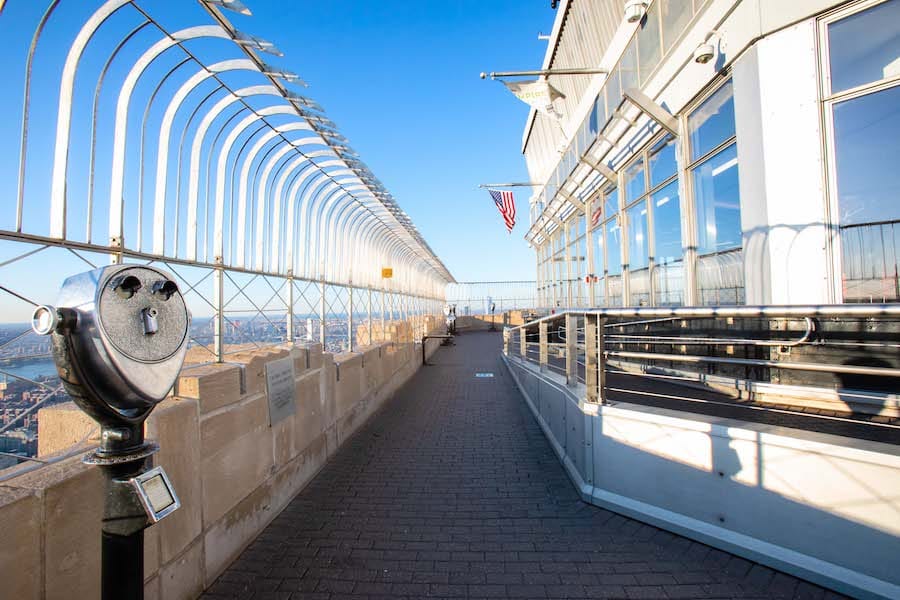
“One of the first steps in the retrofit was to address the exterior of the building and make sure that the building is properly sealed. Then we addressed the windows. Essentially, you work your way out, then inward.
“The exhibit tells that story. We share fun facts, like that we retrofitted 6,514 windows at a pace of about 50 windows per day. And we did this without disruption to any of our tenants. The exhibit aims to educate and inspire our global visitors.”
The energy efficiency project does not just benefit the Empire State Building. It also serves as an example of what is possible – even for a building that is almost 90 years old. The overhaul has contrived to reduce energy usage. It saves millions of dollars in energy costs while sharing with the world the lessons learned during the process.
A fun, sharable experience at the Empire State Building
The Instagrammable elements mean people can share their experience constantly.
It’s important that visitors can share their memories as they create them, whatever the platform…It is about creating an emotional connection with the building
Ghazi says: “It’s important that visitors can share their memories as they create them, whatever the platform. Whether it is Instagram, WeChat, Twitter; whatever they are most comfortable with. It is about creating an emotional connection with the building. One that is sufficiently strong for them to want to engage, to spread the word, share how wonderful their experience has been. The reaction has been great.”
Rethinking interactive experiences
Many of the media experiences Squint/Opera had created were hands-on. This meant that they had to be redesigned in the light of COVID-19.
“We worked with Jean-Yves to make up what we’ve been calling “autoplay” versions of interactive exhibits. Everything at the Empire State Building is presented in nine languages written by native speakers,” says Houghton.
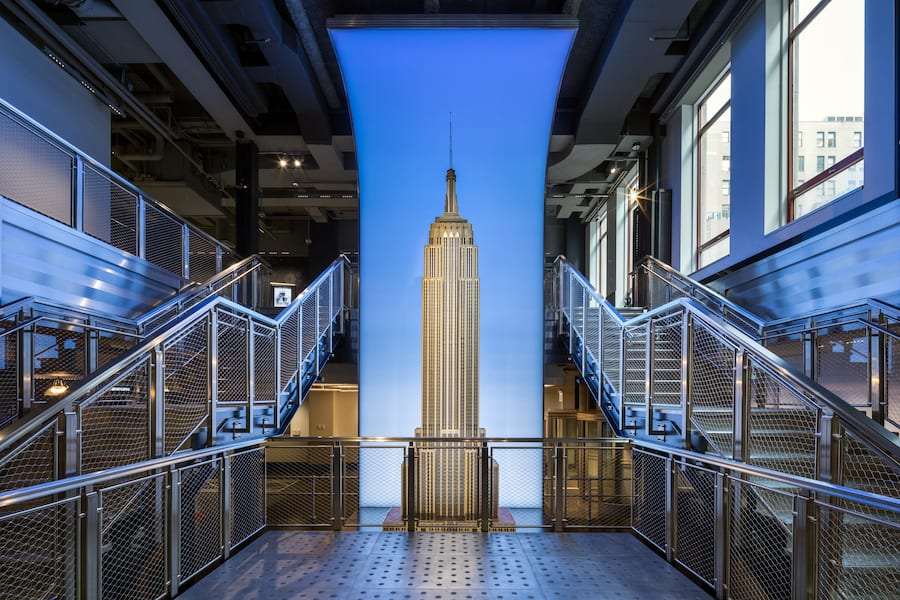
“We had used interactivity quite often to allow someone to pick their language. A very basic interactive feature. During this pandemic time, visitors can no longer use touchscreens. So, we wrote a software script that would auto-play through all the content and languages in sequential order. So that visitors no matter where they are from, can still get the same story without having to touch.
“It’s a new kind of brief for us. For a lot of interactive companies, working with COVID has been tricky. For example, you can’t go to the Empire State Building virtually; it’s not the same experience.
A real-life experience is key
Some experiences can pivot to VR, but this isn’t one of them:
“It does not work,” says Houghton. “This is an experience where you need, physically, to be in the space. Kong can’t attack you unless you’re here. And you can’t actually see the New York skyline. The challenge for us is how do you create the same experience for visitors that will be in a physical space without allowing them to navigate at all themselves?”
The Kong exhibit, where visitors can touch the giant hands that have broken through the walls, feeling them vibrate as he rages outside the window brings an iconic silver screen pop-fiction moment to life in what must, surely, be the highlight of anyone’s visit.
Houghton says:
“I think we were unaware of how popular King Kong would be. It has been unbelievable.”
The Empire State Building and COVID-19

Throughout the pandemic, the Empire State Building, which reopened on July 20, has played a key role.
The hours of operation have been reduced and tickets for set times can be purchased. Initially, capacity dropped by over 80%, allowing only 500 guests in the Observatories’ 70,000 square foot space at a time. The $165 million redevelopment project also created a separate entrance dedicated to Observatory visitors.
In addition to this, the redevelopment incorporates ESRT’s portfolio-wide Indoor Environmental Quality standards. Air quality-related components at the Observatory include MERV 13 air filters, AtmosAir air purification, and constant ventilation.
Guests are subject to a temperature check and must wear a facial covering. Staff are all trained in additional customer service, use of PPE, new cleaning procedures, tracing, and back-of-house protocols.
Celebrating the city
“Our work has been thorough with new training guidelines and customer service standards. We have taken measures with signage, distancing markers, hand sanitisers, and cleaning; beyond anything any retailer or public space we have surveyed,” says Ghazi. “As leaders, we have posted our complete reopening program online for the public to view. Both to give our guests confidence and to help guide other attractions in best practices.”
“At the end of the day, this building is New York City. It has acknowledged the terrible moments and celebrated our first responders through unique lighting events. Leveraging our lights whenever possible highlights that we are, for the city and beyond, a beacon of hope.”
kubik maltbie served as the prime exhibit contractor on the project. Their scope of work included pre-construction consulting to align the project scope and budget, as well as fabrication and installation of all exhibits, interactives, showcases, and graphics.
Images kind courtesy of ESRT. Top image: Macy’s Fireworks, credit Kent Miller
